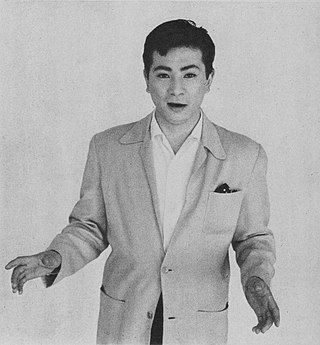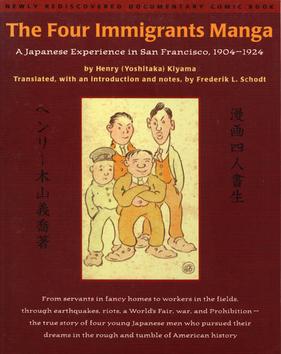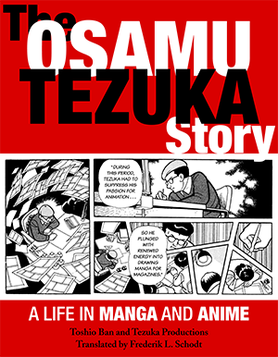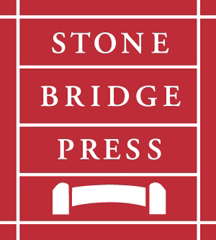
Manga are comics or graphic novels originating from Japan. Most manga conform to a style developed in Japan in the late 19th century, and the form has a long history in earlier Japanese art. The term manga is used in Japan to refer to both comics and cartooning. Outside of Japan, the word is typically used to refer to comics originally published in the country.
Shōnen manga is an editorial category of Japanese comics targeting an audience of adolescent boys. It is, along with shōjo manga, seinen manga, and josei manga, one of the primary editorial categories of manga. Shōnen manga is traditionally published in dedicated manga magazines that exclusively target the shōnen demographic group.

Astro Boy, known in Japan by its original name Mighty Atom, is a Japanese manga series written and illustrated by Osamu Tezuka. It was serialized in Kobunsha's Shōnen from 1952 to 1968. The 112 chapters were collected into 23 tankōbon volumes by Akita Shoten. Dark Horse Comics published an English translation in 2002. The story follows Astro Boy, an android young boy with human emotions who is created by Umataro Tenma after the recent death of his son Tobio. Eventually, Astro is sold to a robot circus run by Hamegg, but is saved from his servitude by Professor Ochanomizu. Astro becomes a surrogate son to Ochanomizu who creates a robotic family for Astro and helps him to live a normal life like an average human boy, while accompanying him on adventures.

Osamu Tezuka was a Japanese manga artist, cartoonist and animator. Born in Osaka Prefecture, his prolific output, pioneering techniques and innovative redefinitions of genres earned him such titles as "the Father of Manga", "the Godfather of Manga" and "the God of Manga". Additionally, he is often considered the Japanese equivalent to Walt Disney, who served as a major inspiration during Tezuka's formative years. Though this phrase praises the quality of his early manga works for children and animations, it also blurs the significant influence of his later, more literary, gekiga works.
Gekiga is a style of Japanese comics aimed at adult audiences and marked by a more cinematic art style and more mature themes. Gekiga was the predominant style of adult comics in Japan in the 1960s and 1970s. It is aesthetically defined by sharp angles, dark hatching, and gritty lines, and thematically by realism, social engagement, maturity, and masculinity.

Shintaro Katsu was a Japanese actor, singer, and filmmaker. He is known for starring in the Akumyo series, the Hoodlum Soldier series, and the Zatoichi series.

In comics, a one-shot is a work composed of a single standalone issue or chapter, contrasting a limited series or ongoing series, which are composed of multiple issues or chapters. One-shots date back to the early 19th century, published in newspapers, and today may be in the form of single published comic books, parts of comic magazines/anthologies or published online in websites. In the marketing industry, some one-shots are used as promotion tools that tie in with existing productions, movies, video games or television shows.
Frederik L. Schodt is an American translator, interpreter, and writer.

Nakayoshi is a monthly shōjo manga magazine published by Kodansha in Japan. First issued in December 1954, it is a long-running magazine with over 60 years of manga publication history. Notable titles serialized in Nakayoshi include Princess Knight, Candy Candy, Pretty Guardian Sailor Moon and Cardcaptor Sakura. Roughly the size of a phone book, the magazine generally comes with furoku, or small gifts, such as pop-out figures, games, small bags, posters, stickers, and so on. The furoku is an attempt to encourage girls to buy their own copies of the magazine rather than just share with a friend.
Alternative manga or underground manga is a Western term for Japanese comics that are published outside the more commercial manga market, or which have different art styles, themes, and narratives to those found in the more popular manga magazines. The term was taken from the similar alternative comics. The artistic center of alternative manga production was from the 1960s until the 1990s the manga magazine Garo, which is why in Japan, alternative manga are often called Garo-kei, even if they were not published in Garo.
An original English-language manga or OEL manga is a comic book or graphic novel drawn in the style of manga and originally published in English. The term "international manga", as used by the Japanese Ministry of Foreign Affairs, encompasses all foreign comics which draw inspiration from the "form of presentation and expression" found in Japanese manga. This may also apply to manga-inspired comics made in other languages.

Donald Richie was an American-born author who wrote about the Japanese people, the culture of Japan, and especially Japanese cinema. Although he considered himself primarily a film historian, Richie also directed a number of experimental films, the first when he was seventeen.

Manga! Manga! The World of Japanese Comics is a 1983 book by Frederik L. Schodt. Published by the Japanese publisher Kodansha, it was the first substantial English-language work on Japanese comics, or manga, as an artistic, literary, commercial and sociological phenomenon. Part of Schodt's motivation for writing it was to introduce manga to English speakers. The book is copiously illustrated and features a foreword by Osamu Tezuka. It also includes translated excerpts from Tezuka's Phoenix, Keiji Nakazawa's Barefoot Gen, and Riyoko Ikeda's The Rose of Versailles, and the Reiji Matsumoto short story "Ghost Warrior".

Dreamland Japan is a 1996 book by Frederik L. Schodt published by Stone Bridge Press that was intended as a "sequel" to Schodt's 1983 book Manga! Manga! The World of Japanese Comics. It includes information on several major manga magazines and manga writers and artists, including many who are little-known outside Japan. The book also includes an extensive chapter on manga "god" Osamu Tezuka and information on developments in manga that took place since the publication of Manga! Manga!, such as the use of manga as propaganda by the Aum Shinrikyo cult, the evolution of "otaku" culture, and the role of computers in manga creation.
Leza Lowitz is an American expatriate writer residing in Tokyo, Japan and in the American Southwest. She has written, edited and co-translated over twenty books, many about Japan, its relationship with the US, on the changing role of Japanese women in literature, art and society, and about the lasting effect of the Second World War and the desire for reconciliation in contemporary Japanese society. She is also an internationally renown yoga and mindfulness teacher recognized for her work bridging poetry and the spiritual path through disciplines like yoga and mindfulness.
Murasaki Yamada, born as Mitsuko Shiratori, was a Japanese manga artist, feminist essayist and poet. She was associated with the alternative manga magazine Garo.
Milk Morizono is the pen name of Hiroko Mizoguchi, a Japanese manga artist and photographer. Noted for her works in the ladies' manga genre that feature ecchi themes and subject material, Morizono has been called the "Queen of Ladies' Manga" and noted by Rachel Matt Thorn as "the most popular and respected creator of erotic manga for women".

The Four Immigrants Manga (1931), also known as The Four Students Manga, is a Japanese-language manga written and illustrated by Henry Kiyama. It is an early example of autobiographical comics.

Richard Risley Carlisle (1814–1874) was an American gymnast and acrobat who often performed as Professor Risley. He is known for developing a circus act of juggling with the feet known as the Risley act. An inveterate traveler to Europe, Australia and East Asia and serial entrepreneur, Risley also notably brought a Japanese circus act to America in the 1860s.

The Osamu Tezuka Story: A Life in Manga and Anime is a biographical manga based on Osamu Tezuka's life, created by Tezuka Productions and Tezuka's assistant Toshio Ban. It was serialized by Asahi Shimbun's Asahi Graph from 1989 to 1992 and collected into two volumes in 1992. It was published in North America by Stone Bridge Press, with a translation by Frederik L. Schodt, on July 12, 2016. The North American edition was nominated for the 2017 Eisner Award in the "Best U.S. Edition of International Material—Asia" category.












